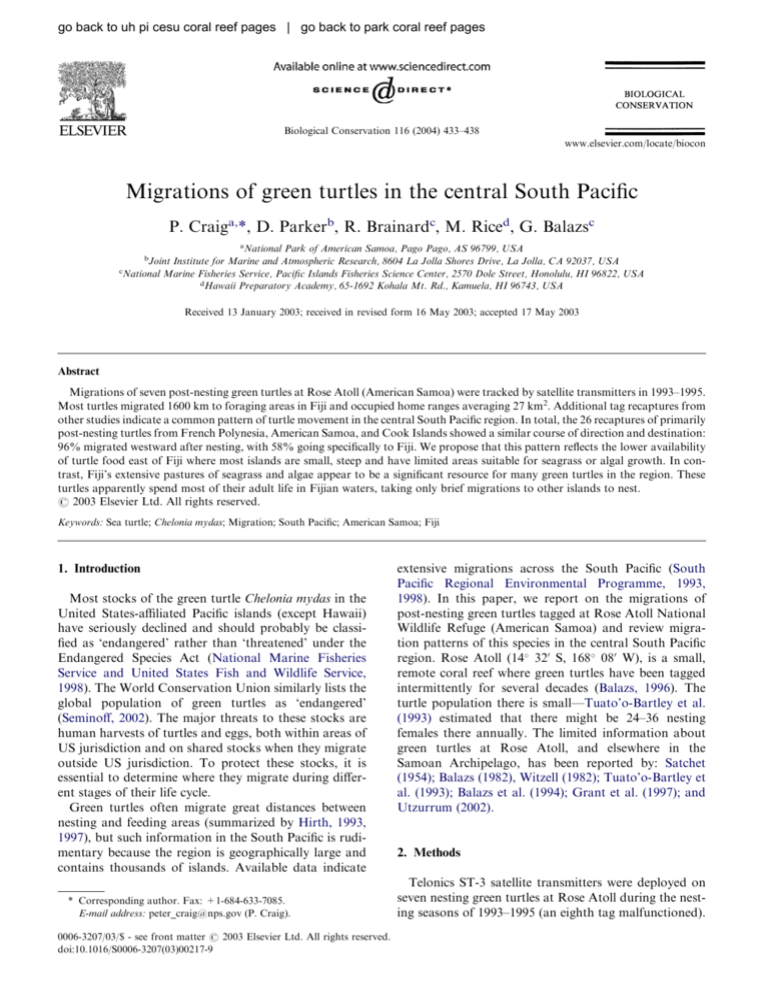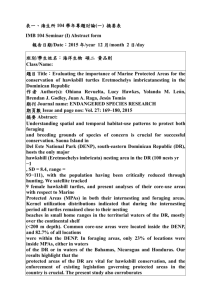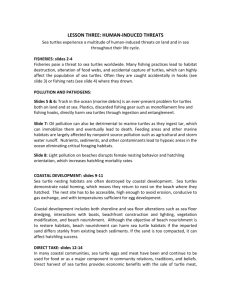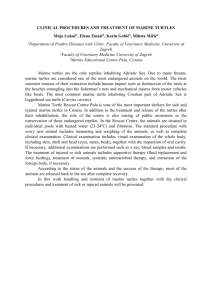
go back to uh pi cesu coral reef pages | go back to park coral reef pages
Biological Conservation 116 (2004) 433–438
www.elsevier.com/locate/biocon
Migrations of green turtles in the central South Pacific
P. Craiga,*, D. Parkerb, R. Brainardc, M. Riced, G. Balazsc
a
National Park of American Samoa, Pago Pago, AS 96799, USA
Joint Institute for Marine and Atmospheric Research, 8604 La Jolla Shores Drive, La Jolla, CA 92037, USA
c
National Marine Fisheries Service, Pacific Islands Fisheries Science Center, 2570 Dole Street, Honolulu, HI 96822, USA
d
Hawaii Preparatory Academy, 65-1692 Kohala Mt. Rd., Kamuela, HI 96743, USA
b
Received 13 January 2003; received in revised form 16 May 2003; accepted 17 May 2003
Abstract
Migrations of seven post-nesting green turtles at Rose Atoll (American Samoa) were tracked by satellite transmitters in 1993–1995.
Most turtles migrated 1600 km to foraging areas in Fiji and occupied home ranges averaging 27 km2. Additional tag recaptures from
other studies indicate a common pattern of turtle movement in the central South Pacific region. In total, the 26 recaptures of primarily
post-nesting turtles from French Polynesia, American Samoa, and Cook Islands showed a similar course of direction and destination:
96% migrated westward after nesting, with 58% going specifically to Fiji. We propose that this pattern reflects the lower availability
of turtle food east of Fiji where most islands are small, steep and have limited areas suitable for seagrass or algal growth. In contrast, Fiji’s extensive pastures of seagrass and algae appear to be a significant resource for many green turtles in the region. These
turtles apparently spend most of their adult life in Fijian waters, taking only brief migrations to other islands to nest.
# 2003 Elsevier Ltd. All rights reserved.
Keywords: Sea turtle; Chelonia mydas; Migration; South Pacific; American Samoa; Fiji
1. Introduction
Most stocks of the green turtle Chelonia mydas in the
United States-affiliated Pacific islands (except Hawaii)
have seriously declined and should probably be classified as ‘endangered’ rather than ‘threatened’ under the
Endangered Species Act (National Marine Fisheries
Service and United States Fish and Wildlife Service,
1998). The World Conservation Union similarly lists the
global population of green turtles as ‘endangered’
(Seminoff, 2002). The major threats to these stocks are
human harvests of turtles and eggs, both within areas of
US jurisdiction and on shared stocks when they migrate
outside US jurisdiction. To protect these stocks, it is
essential to determine where they migrate during different stages of their life cycle.
Green turtles often migrate great distances between
nesting and feeding areas (summarized by Hirth, 1993,
1997), but such information in the South Pacific is rudimentary because the region is geographically large and
contains thousands of islands. Available data indicate
* Corresponding author. Fax: +1-684-633-7085.
E-mail address: peter_craig@nps.gov (P. Craig).
0006-3207/03/$ - see front matter # 2003 Elsevier Ltd. All rights reserved.
doi:10.1016/S0006-3207(03)00217-9
extensive migrations across the South Pacific (South
Pacific Regional Environmental Programme, 1993,
1998). In this paper, we report on the migrations of
post-nesting green turtles tagged at Rose Atoll National
Wildlife Refuge (American Samoa) and review migration patterns of this species in the central South Pacific
region. Rose Atoll (14 320 S, 168 080 W), is a small,
remote coral reef where green turtles have been tagged
intermittently for several decades (Balazs, 1996). The
turtle population there is small—Tuato’o-Bartley et al.
(1993) estimated that there might be 24–36 nesting
females there annually. The limited information about
green turtles at Rose Atoll, and elsewhere in the
Samoan Archipelago, has been reported by: Satchet
(1954); Balazs (1982), Witzell (1982); Tuato’o-Bartley et
al. (1993); Balazs et al. (1994); Grant et al. (1997); and
Utzurrum (2002).
2. Methods
Telonics ST-3 satellite transmitters were deployed on
seven nesting green turtles at Rose Atoll during the nesting seasons of 1993–1995 (an eighth tag malfunctioned).
434
P. Craig et al. / Biological Conservation 116 (2004) 433–438
Average turtle size was 104.4 cm curved carapace length
(range 96.5–113 cm). Satellite tags weighed 765 g (< 1%
of a turtle’s approximate weight) and measured
17103.5 cm with the antenna extending 13 cm from
the top. Tagging procedures were described by Balazs et
al. (1996). Positional data were received and processed
by Service Argos. Argos positional accuracies were less
than 1 km for about 72% of the positions (accuracy
categories LC 1–3) and at least 1 km for about 28% of
the positions (LC 0), although an occasional position
with no positional accuracy estimate was used if there
were multiple days without LC 0–3 data. Data were filtered to eliminate unreasonable swimming speeds or
> 90 directional changes. Tag duty cycles (hours on/
off) were either 6/6 or 3/3.
Migration speed and distance were calculated using
the most accurate position (LC 0–3) per day, if available. Speeds were calculated as the number of hours
taken to traverse the distance traveled during each neardaily period, and the average of these was used as the
overall speed. Total distance traveled was the sum of the
distances between each near-daily distance position.
Home ranges were estimated for those turtles that
reached a resting/foraging area as determined by a turtle
remaining in a general area for over one month. Home
ranges were calculated in ArcView GIS (ESRI) using
positional data with accuracies of 150–1000 m (LC 1–3).
For each turtle, a 1000 m buffer was created around
each position (to account for the least accurate position
category used) and a polygon was created that encompassed all of the buffered points, then the area of the
polygon was determined.
An additional 46 nesting females were tagged opportunistically at Rose Atoll with metal flipper tags during
the period 1971–1996 (Balazs, 1996).
Sea surface currents were tracked by surface drifter
buoys (0.5 m diameter), each equipped with a satellite
transmitter and attached to a large windsock-like drogue about 15 m below the surface (manufactured by
Technocean). Six drifter buoys were deployed throughout American Samoa by the NOAA ship Townsend
Cromwell in February 2002 and were tracked up to 14
months by Service Argos. The net speed of each drifter
was determined once the drifter left the Samoan Archipelago and exhibited directional westerly movement.
Net speed was calculated as the total time elapsed for a
drifter to cross the 670 km distance between longitudes
173 W and 179 W. Potential impacts of El Nino conditions on surface conditions were not addressed.
3. Results
The seven satellite-tagged green turtles remained at
or near Rose Atoll for approximately 2 months before
departing to foraging grounds in late December to
January (Table 1). Six of the seven then migrated westward to Fiji, the seventh traveled in nearly the opposite
direction to French Polynesia near Raiatea (Fig. 1). On
average, these turtles traveled 1600 km at a rate of 1.8
km/hr and were 40 days in transit (Table 1).
Once in Fiji, five of the satellite tags continued transmitting for 1.3–3.5 months thus providing information
about the turtles’ local movements on their feeding
grounds. During this period (February–April), each
turtle took up residence in a different part of Fiji (Fig. 2)
and occupied a relatively small home range averaging 27
km2 in size (Table 1).
There have been only three recaptures of the 46 flipper-tagged adult females from Rose Atoll that had been
tagged in 1971–1996: two in Fiji (both were taken for
food) and one found dead in Vanuatu.
Altogether, 9 of the 10 recoveries (satellite-tags and
flipper-tags combined) migrated westward after nesting,
and 8 of the 10 went to Fiji. While their means of navigation was not investigated, their migration routes closely paralleled ocean surface currents, albeit measured
7–9 years later. All six ocean drifter buoys released in
the territory in 2002 traveled towards Fiji at a net rate
of 0.54 km/h (range 0.40–0.65 km/h) after spending
1–10 months drifting around the Samoan Islands
(Fig. 3).
4. Discussion
The extensive migrations recorded in this study are
similar to those obtained for post-nesting green turtles
elsewhere in the world. Satellite telemetry has demonstrated that green turtles often travel open-ocean distances of 1000–2000 km between their nesting and
foraging areas (summarized in Hirth, 1997; also see
Luschi et al., 1998; Cheng, 2000; Bali et al., in press).
The migrations of green turtles from Rose Atoll,
when coupled with other data from the region, indicate
a common pattern of turtle movement in the central
South Pacific region (Table 2). Altogether, 570 adult
green turtles have been tagged in the region during the
period 1972–2000 (557 nesting females and 13 adult
males at the nesting grounds). Most were flipper-tagged
at Scilly Atoll in 1972–1984 (n=461) and 1991 (n=52),
and were recovered in Fiji (6 turtles), Vanuatu (3), New
Caledonia (2) Wallis Island (1), Tonga (1) and Cook
Islands (1) (Balazs et al., 1995). Another flipper-tagged
green turtle was released in Rangiroa, French Polynesia
and recovered in the Solomon Islands (South Pacific
Regional Environmental Programme, 1993). Finally, a
green turtle was satellite-tagged in the Cook Islands and
recovered in Fiji (Balazs, unpublished data). Average
tag ‘‘recovery’’ rates have been 89% for satellite tags
(n=9) and 3% for metal flipper tags (n=561), although
the recovery rate for flipper tags is probably lower due
435
P. Craig et al. / Biological Conservation 116 (2004) 433–438
Table 1
Tag and migration data for post-nesting green turtles at Rose Atoll, American Samoa
Satellite
tag no.
Tagging date
Size ccla (cm)
Days before
departure
Days in
transit
Speed
(km/h)
Distance
(km)
Endpoint
4807
4808
4809
4805
25692
25693
25694
4 November 1993
3 November 1993
3 November 1993
27 October 1994
23 October 1995
24 October 1995
26 October 1995
100.0
107.0
96.5
100.0
113.0
104.5
109.5
73
48
54
93
60
72
75
37
30
44
53
31
35
50
1.7
2.0
1.7
2.2
1.8
1.8
1.5
1475
1450
1750
1759
1349
1558
1849
Fiji, Lau Group
Fiji, Vanua Levu
Fiji, Vanua Levu
French Polynesia
Fiji, Taveuni
Fiji, Vanua Levu
Fiji, Viti Levu
Averages:
104.4
68
40
1.8
1599
a
b
c
d
Days after
arrivalb
58
66
Home range
(km2)
120
62
41
20
19
–
–
37
48
12
69
27
c
d
Curved carapace length.
Days after arrival before transmissions stopped.
Turtle was apparently captured.
Transmissions stopped before turtle reached foraging site.
Fig. 1. Migration routes of seven green turtles after departing nesting grounds at Rose Atoll National Wildlife Refuge (American Samoa).
Fig. 2. Home range locations of five green turtles (black dots) in resident foraging pastures in Fiji following their post-nesting migration
from Rose Atoll in American Samoa. Actual home range sizes were
approximately one tenth the size of the black dots shown in this figure.
to unreported tag releases in the region. To date, 26
turtles have been recaptured and their migrations were
similar in both direction and destination: 96% traveled
westward after the nesting period with 58% going specifically to Fiji (Table 2).
A plausible explanation for this pattern is that, after
nesting, the turtles migrate westward to better feeding
opportunities. The rationale for this hypothesis is that,
in the central South Pacific, large areas of shallow water
habitat required for expansive growths of seagrass and
algae that are eaten by the turtles become less common
as one proceeds eastward from Fiji. A sharp demarcation line occurs between Fiji and Samoa where the submarine Tongan Trench separates two of the Earth’s
tectonic plates, the Pacific Plate and Indo-Australian
Plate. To the east of the trench, the Pacific Plate can be
characterized as a deep (4–5 km) seafloor punctuated by
a relatively low number of small, steeply sloping islands.
436
P. Craig et al. / Biological Conservation 116 (2004) 433–438
Fig. 3. Tracks of six drifter buoys released at various locations in the Territory of American Samoa, February 2002. After varying months spent
drifting around the Samoan Islands, the drifters travelled westward towards Fiji and beyond.
Table 2
Recaptures of 23 post-nesting and three adult male green turtles in the central South Pacific region
Tag site
Turtles
taggeda
Recaptured
Reference
Total
To west
To Fiji
Rose Atoll, American Samoa
Scilly Atoll, French Polynesia
Rangiroa, French Polynesia
55
513b
1
10
14
1
9
14
1
8
6c
0
Palmerston Atoll, Cook Islands
1
1
1
1
Total
570
26
25 (96%)
15 (58%)
a
b
c
This study
Balazs et al. (1995)
South Pacific Regional Environment
Programme (1993)
Balazs, unpublished data
Includes both satellite and flipper tags.
Includes 13 adult males.
Includes three adult males.
To the west of the trench, the Indo-Australian Plate is
generally less deep and has more and larger islands with
considerable areas of shallow-water habitat suitable for
seagrass and algal growth. As an illustration of this difference, the combined land masses of the small islands
east of the Tongan Trench (7448 km2) amount to less
than half that occurring in the Fiji Islands alone (18,272
km2), and only 15% of the combined islands of Fiji,
Vanuatu, and New Caledonia (49,565 km2) (South
Pacific Commission, 1995).
Adding to this geographical difference in suitable
habitat is the well-known decrease in species diversity as
one proceeds from the Indo-Pacific region eastward into
the Pacific Ocean (e.g., Randall, 1998). Seagrass diversity, in particular, declines from 14 species in the western Indo-Pacific region to only two species in French
Polynesia (Mukai, 1993; Coles and Lee Long, 1999;
Payri et al., 2000). While this does not automatically
imply that seagrass biomass declines as well, we are not
aware of any significant concentrations of seagrass east
of Fiji in the central South Pacific. In contrast, Fiji has
extensive pastures of seagrass (Pritchard, 1982; Hirth,
1971 cited in Guinea, 1993), and Hirth (1997) noted the
close relationship between the distributions of green
turtles and seagrasses in his review of Chelonia mydas.
We recognize that this hypothesis may be an oversimplification for several reasons. (1) It is likely that
additional islands west of Fiji, such as Vanuatu and
New Caledonia, are also important foraging areas for
turtles from central Pacific islands. (2) Green turtles also
eat certain marine algae, sometimes exclusively, but the
distribution of algal biomass in the region is not known;
however, algae also require shallow waters and thus
may be similarly less abundant east of Fiji. (3) Not all
green turtles vacate eastern areas—some juveniles, for
example, reside year-round in the Samoan Archipelago
(Witzell, 1982; Grant et al., 1997) and thus must be able
to find food there.
Despite these caveats, the hypothesis is best considered
as a population response to gain access to sufficient food
resources so that the turtles can recover from migrating
great distances to and from nesting beaches and also
obtain additional food reserves so that they can reproduce again at a later date. That this reproductive recovery
P. Craig et al. / Biological Conservation 116 (2004) 433–438
may take 4–5 years to accomplish (based on the internesting interval of green turtles in Australia—Limpus,
1993; Limpus et al., 1993) emphasizes the need to go
where food resources are greatest. This lengthy internesting interval would also indicate that the Rose Atoll
turtles spend most of their adult life in Fiji. For example, if we estimate (from the satellite tagging data) that a
round-trip migration to nest at Rose Atoll takes
approximately 5 months, and that a trip occurs once
every 4 years on average, then fully 90% of the turtles’
adult life would be spent in Fijian waters.
Consequently, the seagrass and algae beds of Fiji
should be viewed as a regionally significant resource for
many of the green turtles in the central South Pacific.
These foraging areas are vital to the reproductive success of turtles that nest in many other island nations in
the region, and the need to protect such areas is a critical part of sea turtle conservation (Bjorndal, 1999;
Gibson and Smith, 1999).
Acknowledgements
This project was a cooperative effort among several
territorial and federal agencies. We thank the personnel
of the Department of Marine and Wildlife Resources in
American Samoa who helped tag turtles over the years.
We also appreciate the assistance of Ron Hoeke and
June Firing for data management, and the NOAA ship
Townsend Cromwell crew for deploying the sea surface
buoys. Review comments were provided by Thierry
Work, Jeff Polovina, Beth Flint, Peter Dutton, Sallie
Beavers, Judy Kendig, Fran Fiust and George Antonelis.
Funds for satellite tags were provided by the American
Samoa Environmental Protection Agency, National
Park of American Samoa, U.S. Fish and Wildlife
Service and National Marine Fisheries Service.
References
Balazs, G., 1982. Status of sea turtles in the central Pacific Ocean. In:
Bjorndal, K. (Ed.), Biology and Conservation of Sea Turtles.
Smithsonian Institution Press, Washington, DC, pp. 243–252.
Balazs, G., 1996. Historical summary of sea turtle observations at
Rose Atoll, American Samoa, 1839–1993. National Marine Fisheries Service, Honolulu Laboratory, Hawaii (Unpublished report).
Balazs, G., Craig, P., Winton, B., Miya, R., 1994. Satellite telemetry of
green turtles nesting at French Frigate Shoals, Hawaii, and Rose
Atoll, American Samoa. In: Bjorndal, K., Bolten, A., Johnson, D.
(Comps.), Proceedings 14th Annual Symposium on Sea Turtle
Biology and Conservation, National Atmospheric and Oceanic
Administration Tech. Memo. NMFS-SEFSC-351, pp. 184–187.
Balazs, G., Siu, P., Landret, J-P., 1995. Ecological aspects of green
turtles nesting at Scilly Atoll in French Polynesia. In: Richardson,
J., Richardson, T. (Eds.), Proceedings 12th Annual Workshop on
Sea Turtle Biology and Conservation, 1992, National Atmospheric
and Oceanic Administration Tech. Memo. NMFS-SEFSC-361, pp.
7–10.
437
Balazs, G., Miya, R., Beavers, S., 1996. Procedures to attach a satellite
transmitter to the carapace of an adult green turtle, Chelonia mydas.
In: Keinath, J., Barnard, D., Musick, J., Bell, B. (Comps.), Proceedings of the 15th Annual Symposium on Sea Turtle Biology and
Conservation, 1995. National Atmospheric and Oceanic Administration Tech. Memo. NMFS-SEFSC-367, pp. 21–26.
Bali, J., Liew, H-C., Chan, E-H., Tisen, O. Long distance migration of
green turtles from the Sarawak Turtle Islands, Malaysia. NOAA
Tech. Memo. (in press).
Bjorndal, K., 1999. Priorities for research in foraging habitats. In:
Eckert, K., Bjorndal, K., Abreu-Grobois, F., Donnelly, M. (Eds.),
Research and Management Techniques for Conservation of Sea
Turtles. IUCN/SSC Marine Turtle Specialist Group, Pub. 4, pp. 12–
14.
Cheng, I.-J., 2000. Post-nesting migrations of green turtles (Chelonia
mydas) at Wan-An Island, Penghu Archipelago, Taiwan. Marine
Biology 137, 747–754.
Coles, R., Lee Long, W., 1999. Seagrasses. In: Eldredge, L., Maragos,
J., Holthus, P., Takeuchi, H. (Eds.), Marine and Coastal Biodiversity in the Tropical Island Pacific Region. Vol. 2. Pacific Science
Assoc, Honolulu, Hawaii, pp. 21–46.
Gibson, J., Smith, G., 1999. Reducing threats to foraging habitats. In:
Eckert, K., Bjorndal, K., Abreu-Grobois, F., Donnelly, M. (Eds.),
Research and Management Techniques for Conservation of Sea
Turtles. IUCN/SSC Marine Turtle Specialist Group, Pub. 4, pp.
184–188.
Grant, G., Craig, P., Balazs, G., 1997. Notes on juvenile hawksbill and
green turtles in American Samoa. Pac. Sci. 51, 48–53.
Guinea, M. 1993. The sea turtles of Fiji. South Pacific Regional
Environment Programme. Reports and Studies No. 65.
Hirth, H., 1971. South Pacific Islands—marine turtle resources. Food
and Agriculture Organization, United Nations, Rome.
Hirth, H., 1993. Marine turtles. In: Wright, A., Hill, L. (Eds.), Nearshore Marine Resources of the South Pacific, Inst. Pacific Studies
(Fiji), Forum Fisheries Agency (Honiara). International Centre for
Ocean Development, Canada, pp. 329–370.
Hirth, H., 1997. Synopsis of the biological data on the green turtle
Chelonia mydas (Linnaeus 1758). US Fish and Wildlife Service,
Biological Report 97(1).
Limpus, C., 1993. The green turtle, Chelonia mydas, in Queensland:
breeding males in the southern Great Barrier Reef. Wildl. Res. 20,
513–523.
Limpus, C., Miller, J., Parmenter, C., 1993. The northern Great
Barrier Reef green turtle Chelonia mydas breeding population. In:
Zevering, K., Zevering, C. (Eds.), Raine Island and Environs Great
Barrier Reef: Quest to Preserve a Fragile Outpost of Nature. Raine
Island Corp. and Great Barrier Reef Marine Park Authority,
Townsville, Queensland, Australia, pp. 47–50.
Luschi, P., Hays, G., Del Seppia, C., Marsh, R., Papi, F., 1998. The
navigational feats of green sea turtles migrating from Ascension
Island investigated by satellite telemetry. Proc. Royal Soc. Lond. B
265, 2279–2284.
Mukai, H., 1993. Biogeography of the tropical seagrasses in the
western Pacific. Aust. J. Mar. Freshwater Res. 44, 1–17.
National Marine Fisheries Service, United States Fish and Wildlife
Service, 1998. Recovery plan for the US Pacific populations of the
green turtles (Chelonia mydas). National Marine Fisheries Service,
Silver Spring, MD.
Payri, C., de R. N’yeurt, A., Orempuller, J., 2000. Algae of French
Polynesia. Au Vent Des Iles, Tahiti.
Pritchard, P., 1982. Marine turtles of the South Pacific. In: Bjorndal,
K. (Ed.), Biology and Conservation of Sea Turtles. Smithsonian
Institution Press, Washington, DC, pp. 253–262.
Randall, J., 1998. Zoogeography of shore fishes of the Indo-Pacific
region. Zoological Studies 37, 227–268.
Satchet, M., 1954. A summary of information on Rose Atoll. Atoll
Research Bulletin 29, 1–25.
438
P. Craig et al. / Biological Conservation 116 (2004) 433–438
Seminoff, J., 2002. Global status of the green turtle (Chelonia mydas):
a summary of the 2001 status assessment for the IUCN Red List
Programme. In: Kinan, I. (Ed.), Proceedings of the Western Pacific
Sea Turtle Cooperative Research & Management Workshop.
Western Pacific Regional Fishery Management Council, Honolulu,
pp. 197–211.
South Pacific Commission, 1995. South Pacific Economies Pocket
Statistical Summary. Noumea Cedex, New Caledonia.
South Pacific Regional Environmental Programme. 1993. Report
of the 3rd Meeting of the Regional Marine Turtle Conservation
Programme. Apia, Samoa.
South Pacific Regional Environmental Programme. 1998. Regional
marine turtle conservation programme turtle tagging database
report, 1997 & 1998. Apia, Samoa.
Tuato’o-Bartley, N., Morrell, T., Craig, P., 1993. The status of sea
turtles in American Samoa in 1991. Pacific Science 47, 215–221.
Utzurrum, R., 2002. Sea turtle conservation in American Samoa. In:
Kinan, I. (Ed.), Proceedings of the Western Pacific Sea Turtle
Cooperative Research & Management Workshop. Western Pacific
Regional Fishery Management Council, Honolulu, pp. 33–36.
Witzell, W., 1982. Observations on the green sea turtle (Chelonia
mydas) in Western Samoa. Copeia 1982, 183–185.










